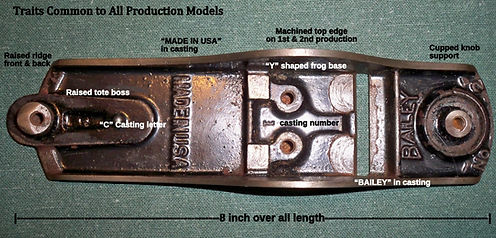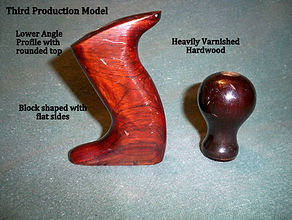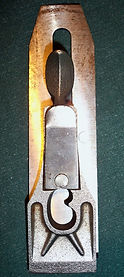
**An In-Depth
Study of the No 2 Stanley Bailey
Hand Plane**
Pat Thomas & Mark Nickel
This is the first in a series of articles, published in no particular order over the next several months, dedicated to number 2 size planes. The main purpose to write such a series is to finally document some of the accumulated knowledge attained over the many years of collecting these planes. It's been frustrating, to say the least, to accumulate and then identify these tools lacking pertinent published information. Type studies and articles have always referenced the larger sized and more common number 3 and 4 sized planes, but these little number 2 planes were mostly ignored. Well, not any more. The goal is to document what we know about them and share this information in a format that is usable for those interested in learning a bit more or maybe trying to identify when a new find that you have unearthed was produced. It also may help you to sadly determine that your great "garage sale" gem is actually a "frankenplane" cobbled together with parts from several deceased donors.
All information presented is based on observations of real unadulterated specimens that have been accumulated over the years. While the author strives to be as accurate as possible, no guarantees of such are implied. We welcome constructive comments and if you have information or examples that add to the knowledge base, please feel free to contact us through this website. This series will always be a work in progress as new specimens and information turn up.
For some history, the Stanley Bailey number 2 size plane was continually produced from the time when Leonard Bailey started production of his patented planes under the Bailey and Woods name in Boston around 1867 until around 1964, when Stanley ceased production of the number 2 size planes. They were never produced in the quantity of the larger and more popular planes such as the 4 or 5 sizes following the laws of supply and demand. Accordingly, they are much more scarce and so hold a higher value to collectors. They also didn't change as frequently as the larger sizes of planes did, i.e. the addition of the frog adjustment screw. They were also very late in the adoption of some of the other changes such as the reshaping of the top of the frog to an ogee shape and the application of the kidney shaped hole in the lever caps. Instead, they kind of evolved in a vacuum and this causes some difficulty in establishing a production period. Maybe the designers in charge of the evolution of the 2s were just lazy. I am not sure, just stating my observations. Honestly, they are a fully usable plane and work well for their intended function of smoothing smaller areas, but anyone with larger hands would have to use an alternate grip of the tote due to the close proximity of the depth adjustment knob to the tote.
Chapter 1: The Long Number 2

The first planes that we would like to discuss is the last in Stanley’s production of the number 2 size, the Long Number 2 as we affectionately call it. It is unknown why the brilliant designers at Stanley would decide to change the number 2 after 85 years of production with few changes to the basic plane for that time, but they did. What they came up with was a longer version of the plane, but kept the 1 5/8 inch cutter that it had since inception. By longer I mean it is a half an inch longer than the previous versions. Their reasoning is still a mystery but one possible explanation is that Stanley was mitigating possible legal action due to truth in advertising statutes.
The 2 size was always advertised as being 7 inches long, but I am not sure where they were measuring. In my observations the side profile measured from 6 1/2 inches on the earliest types to 6 3/4 inches on the last type, before the long 2s came out. The overall length of the earliest types measured 7 1/4 inches from the toe to the end of the tote tab and the last short model at 7 1/2 inches overall. The long 2 actually measures 7 inches long on the side profile and 8 inches long overall. Finally, a measurement that matches the label on the box. There is another thing to note. Even though the 2 size plane in the shorter form always carried a box label stating that the plane that was 7 inches long with a 1 5/8 inch cutter, Stanley continued to use that same box label until production ended, even with the longer planes.
Other than the length changing, Stanley finally added some features to these versions to make it comparable to the rest of their smoothers. The designers modified the frog base on the sole to resemble the rest of the line with the "Y" shape casting supports, but without the frog adjustment screw. They modified the solid face frog with the rounded top to the ogee shaped top frog having the recesses on the face and they finally applied the kidney shaped hole in the lever caps that was applied to most of their line in 1933.I was lucky enough to acquire the prototype of the long number 2 plane and it is part of this presentation. This was an original from the Stanley model shop and it gives us some insight to the development of model revisions. As far as I know it is the only one of this model in existence. It shows how the designers came up with the concept of the longer body and applied the newer frog base and frog to it. It also shows how prototype models vary somewhat from the final production models. It is marked on the side of the frame with the inscription Model 1-4-52 indicating the date of completion. This also gives us our approximate date of when the actual manufacturing began which would be 1952.In the following segment you'll find a "type study" of sorts dealing only with those last production No 2 Bailey planes. The photos illustrate the characteristic changes made to the various components between about 1952 to the end of the model run in about 1964.The author hopes you enjoy this first in the series presentation with several more in the works. Hopefully you will gain some insight and develop a more clear understanding of the Bailey Number 2 through its evolution so stay tuned!
Prototype Model Features (C. 1952)
-
Black Japanning
-
Machined top Edge of Body
-
No Made In USA Cast in Front of Tote in Body
-
Tall Knob with Cup Cast in Body for Knob Base
-
Raised Base Cast in Body for Tote
-
New Y Pattern Frog Base in Casting Unlike the Actual Production Models, Cast Solid From Screw Bosses to Machined Pads in Rear
-
No C or Number Cast Into Body or Frog
-
Etched in Side “Model 1-4-52”
-
Frog Top Edges are Now Ogee Shaped
-
Lateral Lever Does Not Have “STANLEY” Stamp
-
Base of Frog Has Only Rear Half Machined to Mate with Body
-
Black Adjuster Fork on Frog
-
Brass Adjuster Nuts Are Not Large (The Same Size as Earlier Large Planes)
-
Lever Caps Are Nickel Plated with Orange Background Stanley Embossed in Them
-
Lever Cap Hole is Now Kidney Shaped
-
Sculpted Tote Shape Like Earlier Models
-
Thick Varnish and Flat Sides
-
Found in Number 3 Box With Number 2 Label Applied
-
Found With Extra Tote Cut in Half Presumably for Jig Set Up
All Production Model Features
(1952-1964)
Traits Common to All Production Models (C. 1952-1964)
-
8 Inch Body Length From Rear Body Extension To Front Edge
-
Ridges Cast On Front and Rear Top Edges of Body
-
No. 2 Cast On Front Edge of Plane
-
Bailey Cast Behind Front Knob
-
Made In USA Cast in Front of Tote in Body
-
Tall Knob with Cup Cast in Body for Knob Base
-
Raised Base Cast in Body for Tote
-
New Y Pattern Frog Base in Casting
-
C and Number Cast Into Body and Frog
-
Frog Top Edges are Now Ogee Shaped
-
Base of Frog Has Only Rear Half Machined to Mate with Body
-
Brass Adjuster Nuts Are Large ( 1 1/4 inch, The Same Size as Larger Planes)
-
Lateral Levers Have Stanley Stamped Vertically in Them
-
Lever Caps Are Nickel Plated with Orange Background Stanley Embossed in Them
-
Lever Cap Hole is Now Kidney Shaped
-
All cutters have angular tops. None have rounded tops
First Production Model Features
(C. 1952-1955)
-
All common traits and including:
-
Sculpted Tote Shape Like Earlier Models With Thick Varnish and Flat Sides. (Rosewood)
Second Production Model Features
(C. 1956-1958)
-
All common traits and including:
-
Nickel Plated Adjuster Fork on Frog
-
Block Shaped Tote with Flat Top Thick Varnish and Flat Sides. (Rosewood)
Third Production Model Features
(C. 1959-1961)
-
All common traits and including:
-
Japanned Top Edge of Body
-
Body Frog Base Pads Have Notched Corners
-
Block Shaped Tote with Rounded Top Thick Varnish and Flat Sides (Stained Hardwood)
Fourth (Last) Production Model Features (C. 1962-1964)
-
All common traits and including
-
Dark Blue Japanning
-
Full Length Lateral Lever Like Larger Planes
-
Block Shaped Tote with Rounded Top Thick Varnish and Flat Sides (Stained Hardwood)
-
Note: A few of these have turned up with black painted hardwood tote and knob. (Possible Replacements? Same shape as this final production model)




















Chapter 2: The Mythical Stanley Bailey Corrugated Long Number 2
This is the second in our series on the Stanley Bailey number 2 size planes. Hopefully you found the first presentation informative and will return for future articles on as we try to shed some light on these elusive and often misunderstood smaller versions in the Stanley Bailey line. As we dive deeper into the subject we hope to clear up some of the mysteries associated with them and have a little fun in the process.
As the title suggests, this article is about the extremely rare version of the number 2 plane, the long 2 corrugated version. What? A corrugated version of the long 2? Yes, at least one example does exist. All previous information led most of us collectors to believe that corrugated number 2 size

planes were discontinued during Stanley’s World War 2 product line reductions. Sadly, a lot of great tools were dropped from production and presumably the corrugated No 2s were included. Clearly the number of the corrugated versions of the number 2 planes that show up as a whole is limited, They are very scarce but they do occasionally turn up.
Is it real or is it fantasy? We know that in the past and sometimes even today when any commodity has been deemed rare and valuable say a $50 bill, some unscrupulous individual would create their own counterfeit version to sell to unknowing collectors of money, capitalizing on this rarity, (at least in my case) The most notable, as most plane collectors will remember, was the manufacture of the “fake” number 1 size planes. Purely a profit motive in that case, but now those same fakes have become valuable in their own right. Clearly, to manufacture a corrugated version of a standard model plane these days would be relatively easy with available modern technology. However, with careful examination and comparison to a known original, fakes can be identified. It's simple to compare the distance of the corrugations from the mouth and the sole ends from a known authentic model paying close attention to the start and end points as they should be even without variation. Compare the width and depth of the corrugations also. You should easily be able to spot a questionable plane and, unless you are into fakes, buyer beware.
So now that we have talked about some of the history and the possibility of fakes, let’s discuss this previously unknown model of the 2 size. This particular example appears to have been made during the first production period of the long number 2s as was discussed in the first installment. When found in a working shop, it was in well used and extremely dirty condition. It's been examined closely by myself and a few other tool aficionados and the consensus is that it is a real factory made corrugated version of the long 2. This revelation sort of flies in the face of previously accepted convention but as with any speculative “best guess” effort you try your best to get it right and there are clearly limitations in the knowledge base regarding these planes. Stanley was a manufacturer that worked very hard to satisfy customers so it's very possible that certain dealers or individuals could special order a particular special upgrade to their new or existing planes, like corrugations. In the early days planes came with flat bottoms but could be ordered with corrugations at an extra charge. It's certainly possible that the corrugated version was a promotional idea from a customer and Stanley, never wanting miss an “exploitable” moment, obliged. This one came from the southeast United States which has not typically been a hotbed of plane counterfeiters so there just may be other examples out there disguised as common corrugated No 2s waiting to be found. So keep an eye out as you may just unearth a rare collectible. Of course be on the lookout for any corrugated number 2s that were made post WW2. You may just find another mythical plane that was not supposed to exist. Enjoy!

Corrugated Long Number 2 Features (C. 1952-1955)
-
8 Inch Body Length From Rear Body Extension To Front Edge
-
Ridges Cast On Front and Rear Top Edges of Body
-
Machined Top Edge of Body
-
No. 2 Cast On Front Edge of Plane
-
Bailey Cast Behind Front Knob
-
Made In USA Cast in Front of Tote in Body
-
Tall Knob with Cup Cast in Body for Knob Base
-
Raised Base Cast in Body for Tote
-
New Y Pattern Frog Base in Casting
-
C and Number Cast Into Body and Frog
-
8 Corrugations on Sole
-
Frog Top Edges are Now Ogee Shaped
-
Base of Frog Has Only Rear Half Machined to Mate with Body
-
Brass Adjuster Knobs Are Large ( 1 1/4 inch, The Same Size as Larger Planes)
-
Lateral Levers Have Stanley Stamped Vertically in Them
-
Lever Caps Are Nickel Plated with Orange Background with "STANLEY" Embossed in Them
-
Lever Cap Hole is Now Kidney Shaped
-
All cutters have angular tops. None have rounded tops
-
Sculpted Tote Shape Like Earlier Models With Thick Varnish and Flat Sides. (Rosewood)








